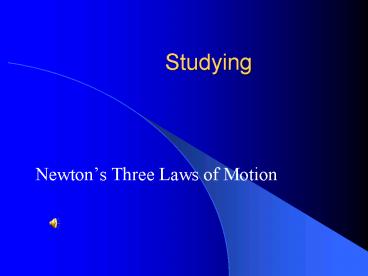Studying - PowerPoint PPT Presentation
Title:
Studying
Description:
Studying Newton s Three Laws of Motion – PowerPoint PPT presentation
Number of Views:66
Avg rating:3.0/5.0
Title: Studying
1
Studying
- Newtons Three Laws of Motion
2
Sir Isaac Newton (January 1643 March 1727)
- Newton's laws of motion are three physical laws
which provide relationships between the forces
acting on a body and the motion of the body.
3
Newtons First Law
- An object at rest will remain at rest- unless
acted upon by an outside force.
4
Newtons First Law
5
Chapter 6
Newtons First Law of Motion
An object at rest remains at rest, and an object
in motion remains in motion at a constant speed
and in a straight line unless acted on by an
unbalanced force.
6
(No Transcript)
7
Chapter 6
Newtons First Law of Motion, continued
8
The First Law is Also Called
- The Law of Inertia
- Inertia is a resistance to change in motion.
9
Can You Explain ?
10
Examples
- An object at rest will remain at rest.
- Activity 1
- Freefall
11
The Tablecloth Trick
12
- An object in motion will continue to move in a
straight line.
- For Example
13
The Story of Fluffy
14
Poor Baby Barbie
15
Anti- Inertia Belts
- Better known as Seatbelts !
16
Chapter 6
Newtons Second Law of Motion
- The acceleration of an object depends on the mass
of the object and the amount of force applied. - Newtons second law describes the motion of an
object when an unbalanced force acts on the
object.
17
Newtons Second Law
- This Law shows the relationship between mass,
force, and acceleration. - When a force is applied to a mass, it accelerates.
18
The larger the mass of an object, the more force
needed to start it, stop it, or change its
direction.
19
(No Transcript)
20
(No Transcript)
21
Chapter 6
Newtons Second Law of Motion
- The acceleration of an object depends on the mass
of the object and the amount of force applied. - Newtons second law describes the motion of an
object when an unbalanced force acts on the
object.
22
Chapter 6
Newtons Second Law of Motion
- Part 1 Acceleration Depends on Mass The
acceleration of an object decreases as its mass
increases. Its acceleration increases as its mass
decreases. - Part 2 Acceleration Depends on Force An
objects acceleration increases as the force on
the object increases. The acceleration of an
object is always in the same direction as the
force applied.
23
(No Transcript)
24
Section 2 Newtons Laws of Motion
Chapter 6
25
Section 2 Newtons Laws of Motion
Chapter 6
26
Newtons Second Law
- For Example A Bowling Ball vs a
ping pong ball.
27
Or Runaway Ramps
28
Choose Your Position..
- Some Athletes are long and lean, with little
body fat, and little muscle. Basketball players
and wide receivers fit this category.
29
Choose Your Position
- Other athletes, on the other hand, have lots
of body fat, lots of muscle, and gain weight
easily. Football lineman and sumo wrestlers are
heavier and rounder individuals
30
Momentum, Mass, and Velocity
- The momentum of an object is the product of the
objects mass and velocity. Object at rest has
zero momentum. - Calculating Momentum The relationship of
momentum (p), mass (m) in kilograms, and velocity
(v) in meters per second, is shown in the
equation below - p ? m x v
31
(No Transcript)
32
What is (i) the total kinetic energy before
the collision (ii) the total kinetic energy
after the collision. (iii) the total loss in
kinetic energy.
33
(No Transcript)
34
The Law of Conservation of Momentum
- The law of conservation of momentum states that
any time objects collide, the total amount of
momentum stays the same.
35
The Law of Conservation of Momentum
- The combined objects have a different velocity
because momentum is conserved and depends on mass
and velocity. - So, when the mass changes, the velocity must
change, too.
36
The Law of Conservation of Momentum, continued
- Objects Bouncing Off Each Other When two
objects bounce off each other, momentum is
transferred from one object to the other. - The transfer of momentum causes the objects to
move in different directions at different speeds.
37
The Law of Conservation of Momentum, continued
- Conservation of Momentum and Newtons Third Law
Conservation of momentum can be explained by
Newtons third law. - Because action and reaction forces are equal and
opposite, momentum is neither gained or lost in a
collision.
38
Forces Always Come in Pairs
- .
39
Newtons Third Law of Motion
- Whenever one object exerts a force on a second
object, the second object exerts an equal and
opposite force on the first. - Newtons third law of motion can be simply
stated as follows All forces act in pairs.
40
(No Transcript)
41
Newtons Third Law
- For every action force, there is an equal, but
opposite, reaction force.
42
The Action Force is Equal in size but Opposite in
Direction.
43
Action and Reaction forces always act on
different objects.
- Action Force The man pushes against the wall.
- Reaction Force the wall pushes on the man.
44
Newton's third law does not mean that forces
always cancel out so that nothing can ever move.
If these two figure skaters, initially at rest,
push against each other, they will both move.
45
Another example Recoil of a gun or cannon
46
OrLaunching a Rocket
47
Or a Lawn Sprinkler
48
(No Transcript)































